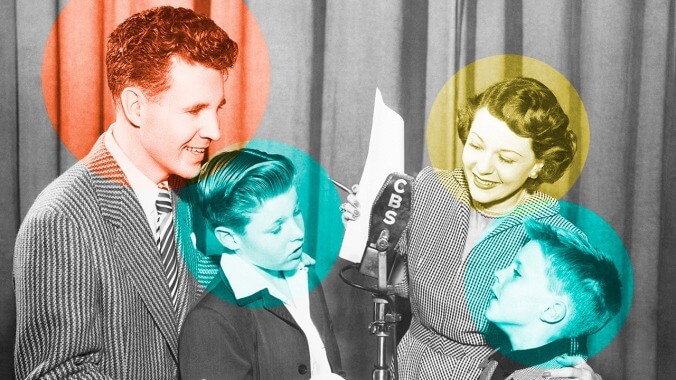CBS built a legacy by raiding comedy talent

CBS turns 90 this year, and few may remember the unprecedented event that put the then-radio network on the map. Almost 70 years ago, CBS head William S. Paley snagged some of NBC’s biggest names in a broadcast milestone known as the “talent raids.”
At the time, CBS was an also-ran behind “General” David Sarnoff and NBC’s Red and Blue networks. Sarnoff, a Russian immigrant and former assistant to the inventor of long-distance radio transmission, Guglielmo Marconi, helped the Radio Corporation Of America build the National Broadcasting Corporation. CBS’s Paley was Sarnoff’s polar opposite: He came from wealth, having witnessed the power of radio firsthand as advertising helped his father’s cigar business take off, and was far more interested in programming than in tubes and wires.
The most popular radio stars of the day had honed their bits for years on the vaudeville circuit: Now with a nationwide audience, comedians like Jack Benny, Bob Hope, Red Skelton, and yes, ventriloquist Edgar Bergen easily translated into listeners’ living rooms. Amos ’N’ Andy, in which two white men played two black cab drivers in Harlem in what amounted to aural blackface, was so popular that NBC aired it several nights a week. It was said if you walked through a neighborhood and all the windows were open, you could hear the entire program without missing a word.
CBS arrived to the radio game a few years after NBC, and with Benny, Amos ’N’ Andy, and more already in the NBC stable, CBS had a hard time catching up, despite Paley’s considerable savvy. By the late ’40s, a fed-up Paley decided to forego the unspoken gentleman’s agreement between the two radio titans and conducted what would become the famous talent raids of 1948-49. When the dust had settled, Paley had swiped from NBC Amos ’N’ Andy, Jack Benny and his various upcoming spin-offs (like The Phil Harris-Alice Faye Show), as well as Bing Crosby (the former Blue Network). Other shows like Bergen’s, Skelton’s, and idealized family sitcom The Ozzie And Harriet Show soon followed the momentum over to CBS. Paley accomplished this feat by courting the radio stars personally, something Sarnoff was unlikely to have done (Benny was likely flattered that the network head flew out to Hollywood to meet with him), as well as offering sweet production deals with a promise toward the next big communications technology.
Not only did getting these already popular programs to switch networks do wonders for CBS’s Hooper ratings, it also showed Paley’s foresight to look toward television. Radio was so huge that many thought TV could never compete, but Paley, apparently, could see the future. In a February 27, 1949 Chicago Tribune article titled, “Paley’s Talent Raids For CBS Have TV Angle,” the former wunderkind (he took over CBS when he was only 26) stated confidently, “I believe that every one of our new performers will prove terrific TV bets.” A Trib article from the week before, “NBC Comes Up With Reply To Raids By CBS,” said that the network was auditioning hundreds of new acts. But the damage had been done: Few of those newcomers were going to have an already established audience like Jack Benny or Bing Crosby.
Many CBS programs like Benny’s and Ozzie And Harriet easily made the transition to TV; other talents, like Fred Allen, and unsurprisingly, Bergen and his ventriloquist act, weren’t as fortunate. CBS was especially ahead of its time by realizing the potential appeal of having women in starring roles: Former radio stars Eve Arden and especially Lucille Ball became vital to CBS’s TV success, in Our Miss Brooks and My Favorite Husband, respectively. Ball lobbied successfully to get her real-life spouse, Desi Arnaz, to play her husband on her show, changing his occupation from banker to Cuban bandleader. The resulting I Love Lucy is still held as one of the pinnacles of TV comedy. Ball and Arnaz turned into TV moguls themselves, as their studio, Desilu Productions, then offered legendary series like Star Trek, Mission Impossible, and The Untouchables to the network.
More future classics soon followed. CBS soon lined up Dick Van Dyke for his own show, followed by Benny protégée Carol Burnett in 1967, and in the ’70s by Mary Tyler Moore and Bob Newhart (who reappeared on the network again in Newhart in the ’80s). Norman Lear built his own comedy empire on CBS during the same era, starting with All In The Family and expanding into several groundbreaking spin-offs and other shows like Good Times and One Day At A Time. Larry Gelbart’s M*A*S*H joined the CBS comedy juggernaut, lasting for 11 seasons.
Several decades later, and the CBS and NBC wars rage on: Although NBC wound up at the top of the ratings at the end of the 2016-17 season, CBS still boasted the greatest number of viewers, with eight of the top 10 dramas: Bull, NCIS, NCIS: New Orleans, NCIS: Los Angeles, Hawaii Five-O, Madam Secretary, Criminal Minds, and Blue Bloods, which this year will match Tom Selleck’s Magnum P.I. milestone of eight seasons.
Its comedy game may no longer be the network’s strongest suit (though The Big Bang Theory shows no signs of slowing down, adding its own spin-off, Young Sheldon, this year). But even in the age of streaming and cable, CBS continues to enjoy success that rests on a key pivot made almost 70 years ago. Today’s prestige series may be housed elsewhere, but in the earliest days of television, CBS had a lock on the best in the business, led by a man who had the ability to see the TV future.